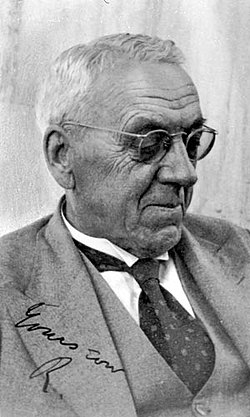Robert Broom
Professor Robert Broom (Paisley, 30 November 1866 – 6 April 1951) was a Scottish, and later South African, doctor and palaeontologist.
He qualified as a medical practitioner in 1895 and received his DSc in 1905 from the University of Glasgow. In 1893 he married Mary Baird Baillie.
From 1903 to 1910 he was Professor of Zoology and Geology at Victoria College, Stellenbosch, South Africa, and subsequently he became keeper of vertebrate palaeontology at the South African Museum, Cape Town.[1]
Contributions
Broom was first known for his study of mammal-like reptiles. After Raymond Dart's discovery of the Taung Child, an infant australopithecine, Broom's interest in palaeoanthropology was heightened. Broom's career seemed over and he was sinking into poverty, when Dart wrote to Jan Smuts about the situation. Smuts put pressure on the South African government, and managed to get a position for Broom. In 1934 he joined the staff of the Transvaal Museum in Pretoria as Assistant in Palaeontology.
In the following years, he and John T. Robinson made a series of spectacular finds, including fragments from six hominids in Sterkfontein, which they named Plesianthropus transvaalensis, but which was later classified as an adult Australopithecus africanus, as well as more discoveries at sites in Kromdraai and Swartkrans.
In 1937, Broom made his most famous discovery of Paranthropus robustus. These discoveries helped support Dart's claims for the Taung species.[2]
The remainder of Broom's career was devoted to the exploration of these sites and the interpretation of the many early hominid remains discovered there. For his volume, The South Africa fossil ape-men, the Australopithecinae, in which he proposed the Australopithecinae subfamily, Broom was awarded the Daniel Giraud Elliot Medal from the National Academy of Sciences in 1946.[3] He continued to write to the very last. Shortly before his death he finished a monograph on the Australopithecines and remarked to his nephew:
- "Now that's finished ... and so am I".[4]
Assessment of his work
"More than any scientist before or since, Broom's work on Australopithecus fundamentally revised the study of fossil man... The significant point is that Broom assigned all except one of these to a single zoological subfamily – the australopithecines, and made it quite clear that [they] were good candidates for the ancestry of mankind".[5]
Books
- Broom R. 1930. The origin of the human skeleton: an introduction to human osteology. Witherby, London.
- Broom R. 1932. The mammal-like reptiles of South Africa, and the origin of mammals. Witherby, London.
- Broom R. 1946. The South Africa fossil ape-men, the Australopithecinae.
- Broom, R. 1950. Finding the missing link. Watts, London.
Robert Broom Media
References
- ↑ Findlay, George H. 1972. Robert Broom F.R.S. Palaeontologist & physician 1866–1951: biography / appreciation / bibliography. Cape Town: A.A. Balkema. ISBN 8696-10181-2
- ↑ D.M.S. Watson 1952. "Robert Broom. 1866–1951" Obituary Notices of Fellows of the Royal Society. 8, #21 pp. 36–70.
- ↑ "Daniel Giraud Elliot Medal". National Academy of Sciences. Retrieved 15 February 2011.
- ↑ Virginia Morell 1995. Ancestral passions: the Leakey family and the quest for humankind's beginnings. Chapter 13.
- ↑ Reader, John 1981. Missing links: the hunt for earliest man. London: Collins, p134. ISBN 0-00-216091-9


